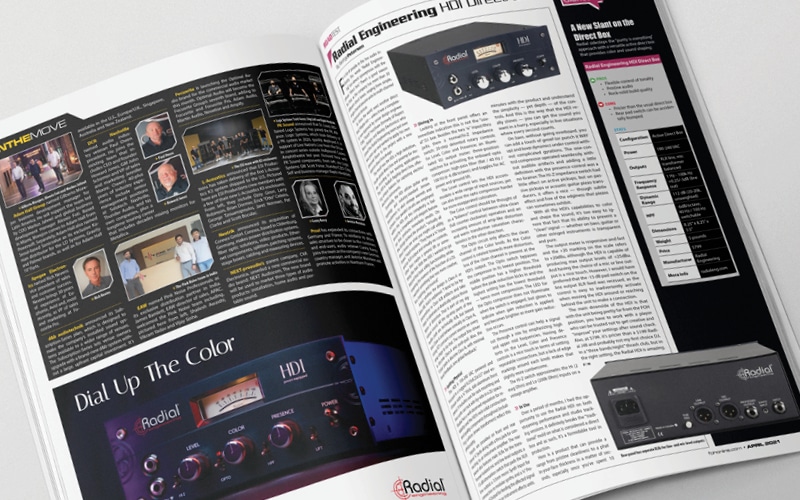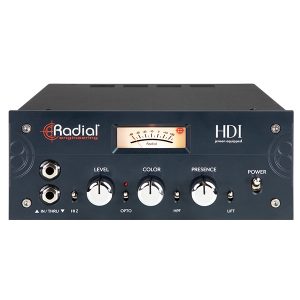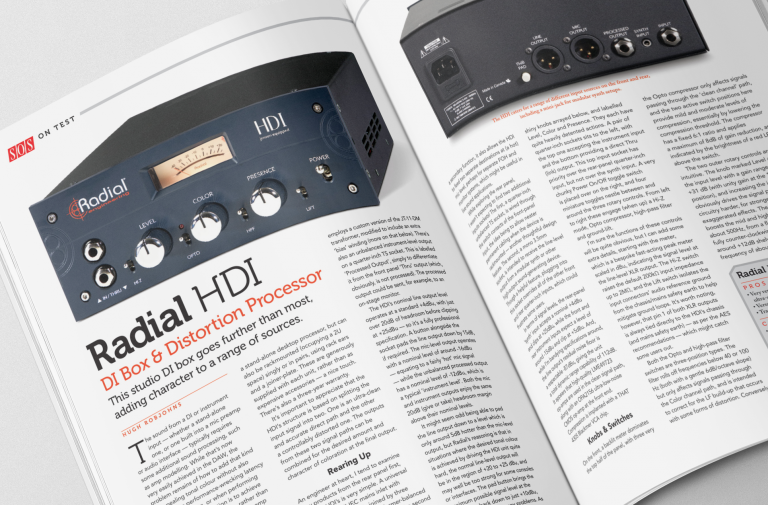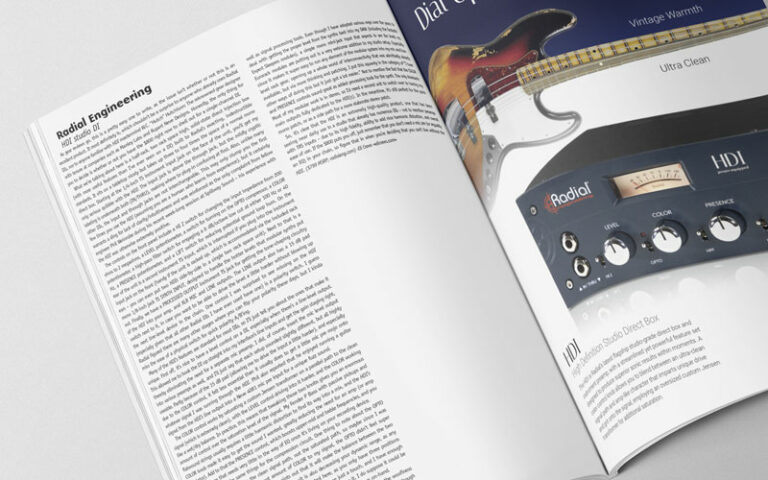The following is written by George Peterson from Front of House. See the Review Here
For a lot of people in the live audio industry, the words “Radial Engineering” are almost synonymous with the phrase “direct box.” There’s a good reason for that, as the company has more than 30 different direct boxes, ranging from simple, single channel passive units to multi-channel rackmount devices. So does the world need another direct box? Maybe not — unless it was a completely new approach by senior design engineer Craig “Hutch” Hutchison (formerly of Rupert Neve Designs and Manley Electronics) who joined the Radial Engineering team just over two years ago and wanted to apply his own personal flavor to the project with a new slant on direct box design.
The result was the HDI, a high definition, studio-grade direct box and preamp for studio recording or live touring applications. The HDI is Radial’s flagship direct box, offering unique features for capturing electric/electronic instruments.
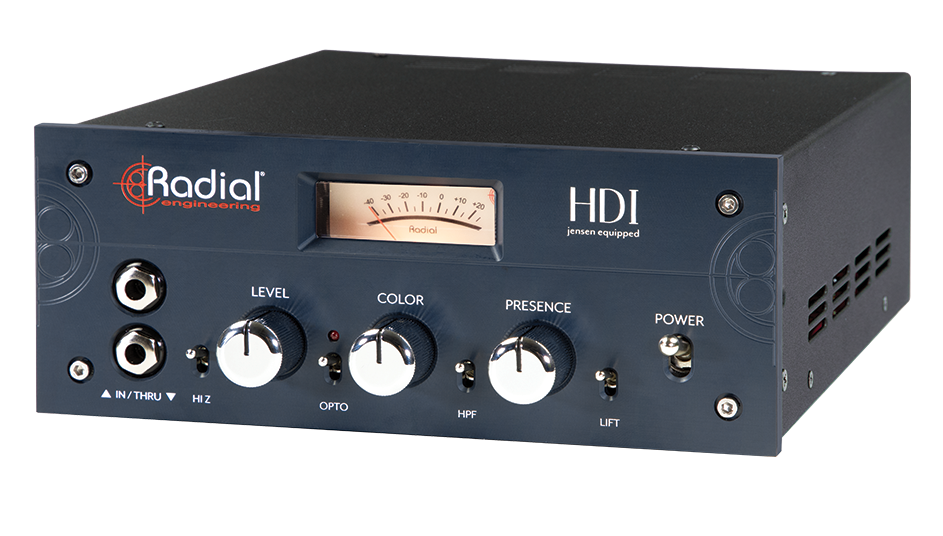
Essentially, the HDI utilizes guitar amp topology and industry-standard Jensen transformers to elicit vintage warmth and richness. Four parallel circuits are employed within the HDI, yet this complexity is balanced by a streamlined and elegant feature set that produces immediate results. On the design behind the product, “Virtually all direct boxes are what you might call utility boxes,” Hutch explains, “They have a ¼″ input and an XLR output and virtually no controls, other than maybe a ground lift or something like that. With the HDI, I wanted to go beyond that basic utility functionality, while retaining the essence of the function of a DI. I wanted something that was more creative, fun, inspiring, and musical.”
Asked whether the design is Class-A or Class-AB, Hutch explained: “I tend to be hypersensitive to Class A/B artifacts and take steps to eliminate or drastically reduce those types of distortion. That is part of my signature sound. All the op-amp parts of the audio path are technically A/B, but biased into Class-A and behave sonically as Class-A, using FET constant current sources on every amp stage to do that. The output line driver is discrete Class-A and push-pull. Also, the ‘Color’ path is discrete Class-A, with minimal local feedback, zero global feedback.”
Getting Physical
The HDI is 100-240 VAC powered and housed in a rugged 8.25×8.25×3.5″ steel enclosure with a ¼″ thick, slab aluminum front panel. It includes ears for rack mounting and two units can rack side-by-side in a 2U space. Radial has a well-deserved reputation for reliability and the HDI’s rock-solid construction and quality components throughout (including custom Jensen transformers) reflect this philosophy.
Inputs are provided on front and rear panel ¼″ jacks along with a thru jack for connecting to an instrument amplifier. The rear panel also features male XLRs for the transformer-isolated mic and line-level outputs; a -15 dB attenuation switch that pads the XLR line output; a 3.5mm mono Synth Input for connection to modular synths; and a ¼″ Processed Output for feeding the affected signal to a guitar amp or instrument effects units.
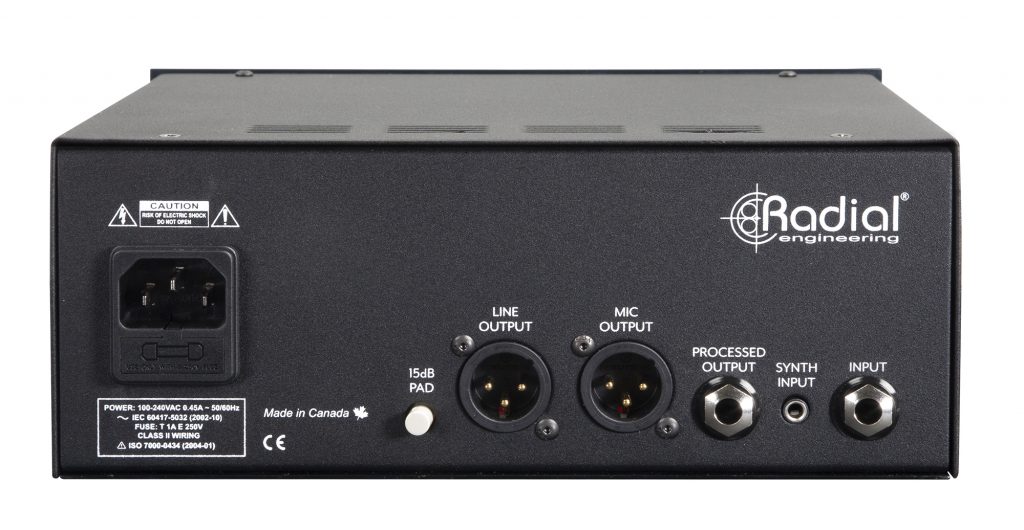
Diving In
Looking at the front panel offers an immediate indication this is not the “usual” D.I. box. Besides the two ¼″ input/thru jacks, there a normal/hi-Z impedance switch; 20-step detented rotary controls for Level, Color and Presence; an illuminated VU output meter; three-position switches for activating the onboard opto compressor; high-pass filter (flat / 40 Hz / 100 Hz @ -6 dB/octave); and toggles for AC power and ground lift.
“Here is a product that can provide a range from pristine cleanliness to a phat in-your-face thickness in a matter of seconds, especially once you’ve spent 10 minutes with the product and understand the simplicity — yet depth — of the controls. And this is the way that the HDI really shines — you can get the sound you want in a hurry, especially in live situations where every second counts”.
The Level control lets the HDI accommodate a wide range of input sources, yet can also drive the opto compressor harder for more exaggerated coloration. The Color control should be thought of as a “balance” control between ultra-clean (full counter-clockwise) operation and an increasing amount of amp-like distortion and warm transformer saturation characteristics in the other direction.
The Opto circuit only affects the clean channel of the Color knob. As the Color control is rotated towards more distortion, less of the clean channel is present at the HDI’s output. The Opto switch bypasses the compressor in its lowest position. The middle position has a higher threshold before the peak reduction kicks in and the highest setting has the lowest threshold — hence more compression. The LED for the Opto compressor does not illuminate when the switch is engaged, but glows to indicate when gain reduction is applied and becomes brighter as more gain reduction occurs.
The Presence control can help a signal cut through a mix by emphasizing high and upper mid frequencies, Having detents on the Level, Color and Presence controls is a nice touch in terms of setting repeatable connections, but a lack of edge markings around each knob makes that slightly more cumbersome.
The Hi-Z switch approximates the Hi (2 meg Ohm) and Lo (200k Ohm) inputs on a vintage amplifier.
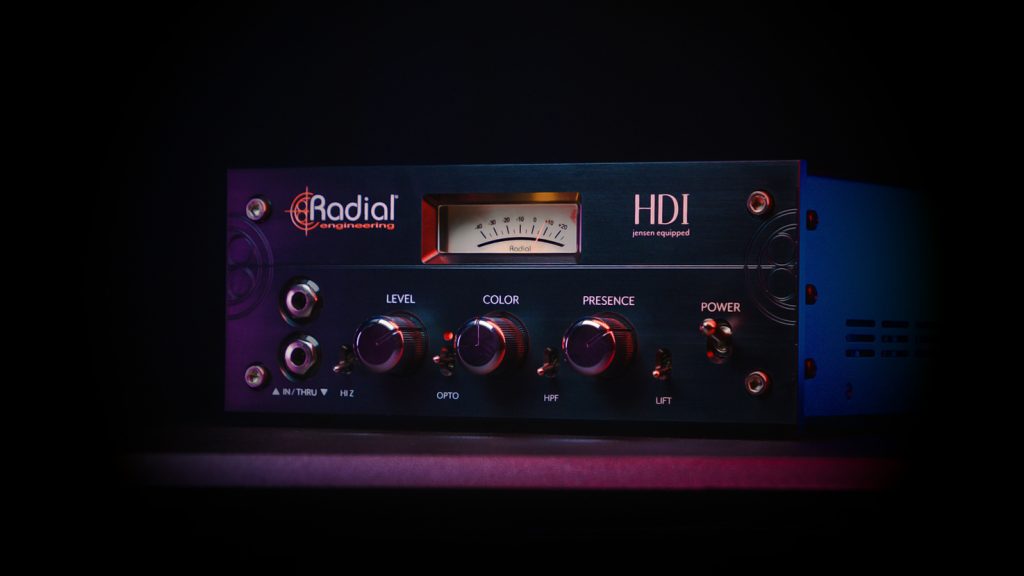
In Use
Over a period of months, I had the opportunity to use the Radial HDI on both streaming performance and studio tracking sessions. It definitely breaks the “traditional” mold on what is considered a direct box and as such, it’s a formidable tool in production.
Here is a product that can provide a range from pristine cleanliness to a phat in-your-face thickness in a matter of seconds, especially once you’ve spent 10 minutes with the product and understand the simplicity — yet depth — of the controls. And this is the way that the HDI really shines — you can get the sound you want in a hurry, especially in live situations where every second counts.
On bass, without going overboard, you can add a touch of growl (or punch it WAY up) and keep dynamics under control without complicated gyrations. The one-control compressor operated seamlessly, without audible artifacts and adding a little definition with the presence control was a no-brainer. The Hi-Z impedance switch had little effect on active pickups, but on passive
pickups or acoustic guitar piezo transducers, it offers a nice — though subtle effect and free of the edginess that piezos can sometimes exhibit.
With all the HDI’s capabilities to color and shape the sound, it’s too easy to ignore that fact that its ability to present a “clean” signal — whether on bass, guitar or other stringed instruments is transparent and pure.
The output meter is responsive and fast and the +20 marking on the scale refers to +20dBu, although the HDI is capable of producing max output levels of +25dBu. And having the choice of a mic or line output is a nice touch. However, I would have preferred that the -15 dB pad switch on the line output XLR feed was recessed, as the control is easy to inadvertently activate when moving the HDI around or reaching behind the unit to make a connection.
The main downside of the HDI is that with the unit being pretty far from the FOH position, you have to work with a player who can be trusted not to get creative and “improve” your settings after sound check. Also pricier than a Radial J48 and probably not my first choice D.I. in a “three bands/night” thrash club, but in the right setting, the Radial HDI is amazing.

